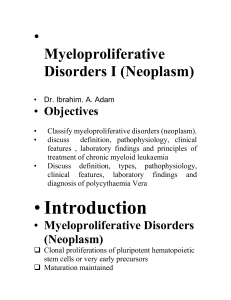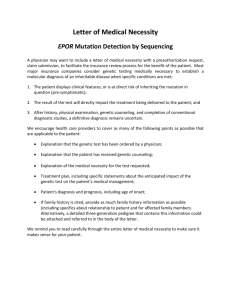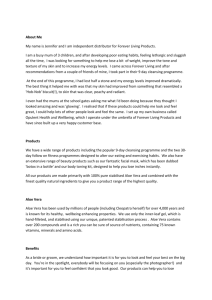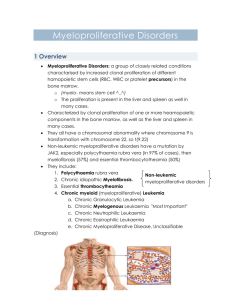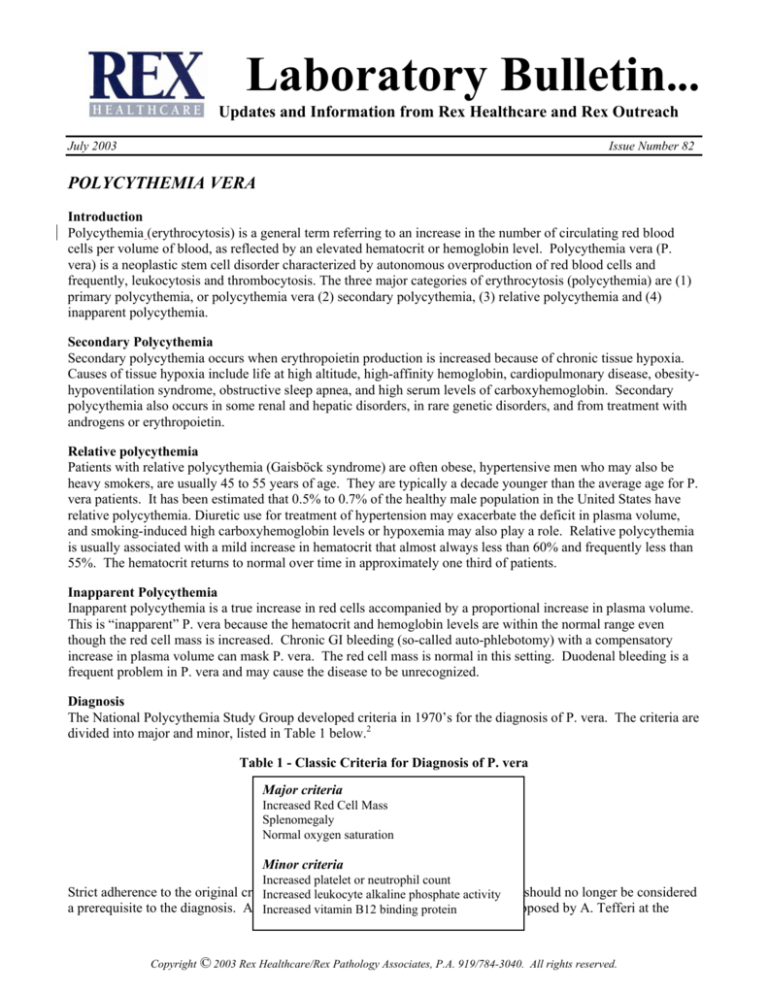
Laboratory Bulletin...
Updates and Information from Rex Healthcare and Rex Outreach
July 2003
Issue Number 82
POLYCYTHEMIA VERA
Introduction
Polycythemia (erythrocytosis) is a general term referring to an increase in the number of circulating red blood
cells per volume of blood, as reflected by an elevated hematocrit or hemoglobin level. Polycythemia vera (P.
vera) is a neoplastic stem cell disorder characterized by autonomous overproduction of red blood cells and
frequently, leukocytosis and thrombocytosis. The three major categories of erythrocytosis (polycythemia) are (1)
primary polycythemia, or polycythemia vera (2) secondary polycythemia, (3) relative polycythemia and (4)
inapparent polycythemia.
Secondary Polycythemia
Secondary polycythemia occurs when erythropoietin production is increased because of chronic tissue hypoxia.
Causes of tissue hypoxia include life at high altitude, high-affinity hemoglobin, cardiopulmonary disease, obesityhypoventilation syndrome, obstructive sleep apnea, and high serum levels of carboxyhemoglobin. Secondary
polycythemia also occurs in some renal and hepatic disorders, in rare genetic disorders, and from treatment with
androgens or erythropoietin.
Relative polycythemia
Patients with relative polycythemia (Gaisböck syndrome) are often obese, hypertensive men who may also be
heavy smokers, are usually 45 to 55 years of age. They are typically a decade younger than the average age for P.
vera patients. It has been estimated that 0.5% to 0.7% of the healthy male population in the United States have
relative polycythemia. Diuretic use for treatment of hypertension may exacerbate the deficit in plasma volume,
and smoking-induced high carboxyhemoglobin levels or hypoxemia may also play a role. Relative polycythemia
is usually associated with a mild increase in hematocrit that almost always less than 60% and frequently less than
55%. The hematocrit returns to normal over time in approximately one third of patients.
Inapparent Polycythemia
Inapparent polycythemia is a true increase in red cells accompanied by a proportional increase in plasma volume.
This is “inapparent” P. vera because the hematocrit and hemoglobin levels are within the normal range even
though the red cell mass is increased. Chronic GI bleeding (so-called auto-phlebotomy) with a compensatory
increase in plasma volume can mask P. vera. The red cell mass is normal in this setting. Duodenal bleeding is a
frequent problem in P. vera and may cause the disease to be unrecognized.
Diagnosis
The National Polycythemia Study Group developed criteria in 1970’s for the diagnosis of P. vera. The criteria are
divided into major and minor, listed in Table 1 below.2
Table 1 - Classic Criteria for Diagnosis of P. vera
Major criteria
Increased Red Cell Mass
Splenomegaly
Normal oxygen saturation
Minor criteria
Increased platelet or neutrophil count
Strict adherence to the original criteria
of theleukocyte
Nationalalkaline
Polycythemia
Study
Group should no longer be considered
Increased
phosphate
activity
a prerequisite to the diagnosis. An Increased
alternate vitamin
diagnostic
approach
(see
Figure
1) proposed by A. Tefferi at the
B12 binding protein
Copyright © 2003 Rex Healthcare/Rex Pathology Associates, P.A. 919/784-3040. All rights reserved.
Mayo Clinic utilizes new laboratory tests to define the disease. 1,3 The algorithm is a paradigm shift from the
classic criteria and not accepted by all. After confirmation of the hemoglobin and hematocrit, the algorithm
begins with the evaluation of specific clinical findings. He utilizes serum erythropoietin (EPO), bone marrow
examination and the endogenous erythroid colony (EEC) assay (growth of erythroid colonies without stimulation)
instead of the classic major and minor criteria listed above. An increase in erythrocytes results in a compensatory
suppression of the EPO level. Therefore, low EPO levels in conjunction with abnormally high hemoglobin is
highly suggestive of P. vera. Among the causes of erythrocytosis, only P. vera has below-normal serum EPO
levels. A positive EEC assay in the presence of below-normal serum EPO levels is specific for P. vera. However,
the EEC assay is not widely available and requires a high level of expertise to perform. If the EPO level is
increased, the cause for the erythrocytosis is secondary polycythemia (tissue hypoxia). If the EPO level is normal
and the hemoglobin and hematocrit values are >18.5g/dl and >60% in males and >16.5 and >53% in females, the
work-up proceeds to evaluate for P. vera. Noticeably absent in the algorithm is the red cell mass study.
Figure 1. Diagnostic approach to suspected erythrocytosis1
*P.vera related features include portal vein thrombosis, Budd-Chiari syndrome, splenomegaly, erythromelalgia,
persistent leukocytosis, thrombocytosis, or microcytosis, post-bath pruritus and digital ischemia.
Clinical Features of P. vera
Clinical findings are of greatest importance in making the diagnosis of P. vera. The usual P. vera patient is over
60 years of age, with slightly more men than women developing the disease. They may exhibit a flushed or ruddy
Copyright © 2003 Rex Healthcare/Rex Pathology Associates, P.A. 919/784-3040. All rights reserved.
appearance. While some patients with P. vera may experience no symptoms, clinical features that are commonly
seen in P. vera are listed in Table 2 below.
Table 2 - Polycythemia vera ( Clinical Features)
Hyperviscosity symptoms (dizziness, headaches, visual changes, paresthesias, fatigue)
Splenomegaly, night sweats
Post bath pruritus (itching)
Digital ischemia
Budd-Chiari syndrome
Erythromelalgia (pain, throbbing burning in one or more extremities)
Unusual thrombotic history
Retinal vein distention
Laboratory Features of P. vera
Polycythemia vera patients are often asymptomatic, presenting with an incidental elevated hemoglobin or
hematocrit. Leukocytosis, thrombocytosis, occasional circulating immature white blood cells, or increased
basophils suggest a myeloproliferative disorder such as polycythemia vera. Numerous tests may be utilized to
reach a diagnosis and are listed in Table 3 below.
Table 3 - Polycythemia vera (Laboratory Values)
Elevated Hematocrit (>60% in men and > 53% in females)
Persistent leukocytosis
Persistent thrombocytosis
Red cell microcytosis due to iron deficiency (low MCV)
Low Erythropoietin level
Red cell mass study
Elevated vitamin B12 and LAP score
Bone marrow pan-hyperplasia with atypical megakaryocytes
Clonal cytogenic abnormalities
In vitro endogenous erythroid colonies (EEC)
Oxygen dissociation P50 of erythrocytes
Red Cell Mass (RCM) measurement
During the past several years, it has become evident that the RCM measurement may not be reliable or necessary
to make the diagnosis of P. vera. RCM is not able to separate P. vera from secondary erythrocytosis. Also,
patients with early P. vera or who have either concurrent iron deficiency may not fulfill the classic criterion of an
increased RCM proposed by the National Polycythemia Study Group. The RCM is redundant when the
hemoglobin is increased higher than 18.5 g/dl in men and 16.5 g/dl in women. This degree of increase is almost
always associated with in increased RCM. At Rex Lab the normal range of the RCM study is adjusted for sex,
height and weight. The adjusted normal range may result in labeling a small number of the normal population as
having P. vera because of the “statistically narrow” limits. On the other hand, a wide normal range would miss
cases of increased red cell mass. The red cell mass is expensive to maintain and run for the low volume of studies
ordered by physicians (less than one a month) and may be discontinued in the future.
Treatment
The mainstay in therapy is phlebotomy. Removal of 500 cc. (one unit) of blood is performed on a daily or weekly
schedule until target hematocrit levels are reached: <45% in men and <42% in women. Patients older than 60
and those with a history of thrombosis usually need some chemotherapy. Treatment with regular strength aspirin
should be avoided. Although it has an antiplatelet effect , aspirin increases the risk of gastric bleeding. Low-dose
aspirin (81mg/day) has a decreased risk of gastric bleeding and can be used to treat vasomotor symptoms. In
contrast to hemochromatosis patients, the phlebotomized blood from P. vera patients cannot be used in the general
donor pool since it is considered a neoplastic hematologic disorder.
Copyright © 2003 Rex Healthcare/Rex Pathology Associates, P.A. 919/784-3040. All rights reserved.
Summary
The algorithm and discussion are provided as suggestions for an alternative approach to the evaluation of
erythrocytosis. A diagnosis of P. vera should be based primarily on the clinical presentation and patient history.
Laboratory findings alone cannot diagnose P. vera and must be correlated with patient information. Strict
adherence to the classic criteria of the National Polycythemia Vera Study Group should not longer be considered
a prerequisite to the diagnosis of P. vera. Once diagnosed, patients with P. vera can undergo treatment to
minimize their risk for the serious, life-threatening complications that accompany P. vera.
Stephen V. Chiavetta, MD
References:
1. Ayalew Tefferi, MD, “Diagnosing Polycythemia Vera: A Paradigm Shift” Mayo Clinic Proceedings, February 1999,
Volume 74, pages 159 – 162.
2. Virginia C. Broudy, MD, WebMD Scientific American Medicine, Hematology Chapter V, The Polycythemias, p 1-10.
3. Polycythemia Vera, Mayo Reference Communique′, April 2003, Volume 28, Number 4, p. 1 – 4.
Questions about the diagnosis of polycythemia vera
1.
Which one of the following statements about
erythrocytosis in polycythemia vera is true?
a. It is erythropoietin independent.
b. It is erythropoietin dependent.
c. It is reactive
d. It is always detected by measurement of the red
cell mass.
e. It is always detected by measurement of plasma
volume
4.
Which one of the following best describes the
serum erythropoietin level in polycythemia vera?
a. Always low
b. Usually low but can be normal
c. Usually normal but can be low
d. Can be low, normal or increased
e. Always normal
2.
Which one of the following is correct regarding
relative polycythemia?
a. An increased red cell mass (RCM)
b. A decreased RCM
c. An increased plasma volume
d. A decreased plasma volume
e. An increased RCM and decreased plasma volume
5.
3.
Which one of the following combinations refers to
inapparent polycythemia?
a. Normal red cells mass (RCM) and decreased
plasma volume
b. Normal RCM and increased plasma volume
c. Increased RCM and decreased plasma volume
d. Increased RCM and normal plasma volume
e. An increased RCM and increased plasma volume
During the assessment of a patient with a
hemoglobin value of 20 g/dl, which one of the
following steps is necessary?
a. Measure red blood cell mass
b. Measure plasma volume
c. Measure serum erythropoietin
d. consider the possibility of relative polycythemia
e. consider the possibility of inapparent
polycythemia
Correct answers:
1. a, 2. d, 3. e, 4. b, 5. c
REX Healthcare Laboratory (784-3040). Telephone extensions are: Pathologists’ Direct Line (3063), Sharon Logue (Lab Director 2400),
Robin Ivosic (Outreach and Microbiology Lab Manager 3053), Elaine Patterson (Core Lab Manager 3054), Jackie Okoth (Core Lab PM
Manager 4248), Diane Young (Anatomic Pathology Manager 3888), Nga Moore (Customer Service Manager 3396), Diane Stephenson
(Blood Bank Manager 4767), Justin Hodges (Blood Plan Manager 4750). Client Response Center 784-6000 (phone), 784-6299 (fax)
Copyright © 2003 Rex Healthcare/Rex Pathology Associates, P.A. 919/784-3040. All rights reserved.

